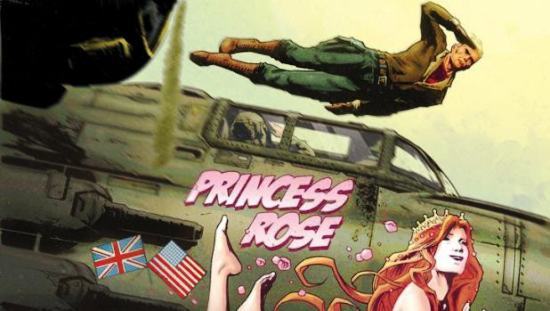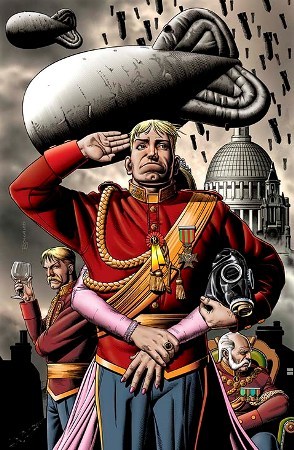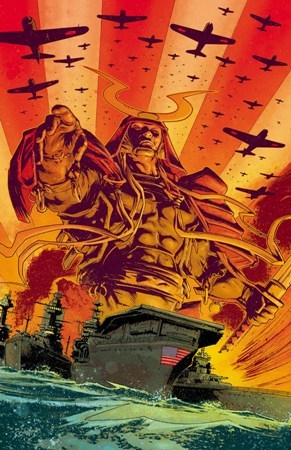After initially pursuing a career as both a freelance journalist and corporate videographer, Rob Williams ended up opting for a wholly different tack: comic book writer. That was 12 years ago, and, since then, he's written for a number of high-profile properties at all three of the big publishers on this side of the pond (such as the X-Men, Superman, and Star Wars), as well as helming several titles in his native England (including Asylum, Meet Darren Dead and The Ten Seconders).
His latest project is The Royals, a six-issue miniseries being handled by DC Comics's Vertigo imprint, which saw its first issue release this week. Set amidst World War II, the story revolves around the British royal family -- which just so happens to be super-powered -- breaking a centuries-long truce to enter the conflict and help advance the cause of their smallfolk. Williams sat down to discuss the title, superhuman eugenics, the rigors of historical research and "destruction porn" in a post-Man of Steel world.
Which came first: the idea to do a different battle each issue, or the idea to jump ahead in these characters' lives?
The structure just seemed to fit. We had six issues to tell a story that I wanted to span the history of the Second World War, and the war lasted six years. So skipping forward a year each issue seemed a solid structural approach. Plus, that way, you get to see the effects of the events upon the characters. They start off happy, idealistic and they're all very different people by the time we reach the end of our story. So, from there, it was choosing a major event from the conflict that took place in each year: the Battle of Britain, Pearl Harbor, the Battle of Midway, Stalingrad, D-Day and, finally, Berlin. But, saying that, the war is very much the backdrop for the series. First and foremost, it's a story about one family.
I can't help but see a certain correlation between the British royal family's desire to keep their bloodline "pure" and the eugenics of the Nazis. How much of this was a conscious decision when designing the story, and how much do you hit upon this in the miniseries?
Showing difference in class was a conscious decision. The Royals, when we first meet them, are enjoying a lavish ball in Buckingham Palace while, outside, the East End of London is being bombed daily by the Luftwaffe. You can't tell a story about royals without dealing with issues of class to an extent. The purity of the bloodline means the greater the powers, hence the inbreeding that's gone on in royal circles for thousands of years. That does all somewhat mirror the eugenics of the Nazis that they're battling, of course -- the idea of the superman. And Germany does have their own royalty in the series, as you'll see.
You've said before that the story contains "big-scale action with huge set pieces, and when things go 'boom,' they really go 'boom.'" How difficult is it to make an impact (no pun intended) in this regard, when the American comic book industry has had superhero-fueled fisticuffs for the past 70-plus years?
Oh, absolutely. Every DC and Marvel Universe book features superfolk battling one another. I think what's different about The Royals, I hope, is the idea of scale. Images of our Royals flying are one thing -- we're kind of desensitized to the wonder of that these days. But a splash image of them flying alongside a squadron of B17 bombers on a raid over Europe -- suddenly there's contrast. And that's true of all the battles in the series. There are royal super humans fighting in the war, but they're very rare. Mostly, the battles play out as they did in World War II. So, when something extraordinary happens, it's against a real-world backdrop. And you see the effect it has on ordinary human beings. I think that makes it have a visceral, emotional effect once again. Plus, I should say that Simon Coleby has made our battle sequences look amazing -- huge swathes of detail there, and they are very dynamic. Spectacle plays a large role in the book.
Conversely, what's the risk of going overboard on the double-page spreads and hitting "destruction porn," particularly in a post-Man of Steel world?
Sure. It's got to be about characters, first and foremost, or no one will care. It's always a fine line, but I think we were constantly conscious of trying to remain respectful to the conflict throughout. And, as I said earlier, this is the story of a family -- their heartaches, their love, deceit, triumphs and failures. It's no good going for huge explosions if you don't care about the people in the midst of the action.
It seems like you and Simon have done due diligence in the historical research category. What was the fundamental draw in doing a WWII book -- the dramatic tension it naturally provides? The desire to create another world that just so happens to be real instead of sci-fi? Socio-political commentary?
All those things, but it comes down to a pure interest in the era, which I have. And, without wishing to make us both seem flippant, Simon and I are both big plane buffs, and we love the aircraft from the era. I think we were moaning to each other about how period comics telling stories from the era never make the aircraft look right. So we wanted to do a book where the reference was faithful throughout. The Japanese ships you see in the Battle of Midway chapter, they're the real ships from the battle. The spitfires you see in issue one and the Battle of Britain, we've tried to make sure they had the 1940 coloring on their undersides -- things like that. Of course, that creates a lot of work for the artist. Simon said to me after finishing that he'd never do a period book again -- the reference was back-breaking. But, hopefully, the book stands out as a result.
And why is it do you think that other creators don't do the historical homework?
Well, I'm sure there's going to be things we've missed. But we tried to do due diligence. Simply put, though, it's a lot of work to research a historical period properly. As long as you're interested in the period, as Simon and I are in this case, it's no hardship. But on a traditional monthly comic schedule, you can see why reference falls between the cracks.
Bringing in Jimmu, the original Japanese emperor, is an inspired touch, given just how differently Japan's history has played out regarding its monarchy -- just when the British were putting the king in his place and establishing democracy, the Japanese daimyo/shogun were finally submitting to the emperor's total authority. Can you speak to the thought process that brought about Jimmu's inclusion?
Well, Japan was obviously going to be a major player in the book. And, also, when I looked around the world at traditional monarchies, you see that Japan has one of the oldest. And the first emperor was Jimmu. So the idea of him being immortal due to his immense power, and still being on the throne of Japan, was an interesting touch, I thought. Then that raises the issue of: If this is the most powerful being on the planet, why hasn't he conquered the world? That's partly how the idea of the truce came about. When we start the series, all the royals across the globe have signed a treaty to not get involved in international conflicts. For the lower-level royals, that's partly born out of self-defense. They saw what happened to the Russian royal family in 1918 at the hands of the Bolsheviks. For someone like Jimmu, who has been through so many wars over an immortal life, he's rather sick of conflict when he first enters the story. But when the idealistic actions of Prince Henry at the Battle of Britain break the truce, all bets are off. And Jimmu hasn't had a war for a while.
Why go with an American publisher instead of a British one? Does the story have different reverberations in the different culture?
Vertigo was good enough to commission the book, simply. But, also, doing it in the American format gives the story much more room to breath, visually especially. In the UK, we have 2000 AD, who Simon and I have worked for for years, and we could have done The Royals there, but 2000 AD tells tales in five-story chunks. The Royals is a very cinematic comic. It's the type of story that needs a big screen.



